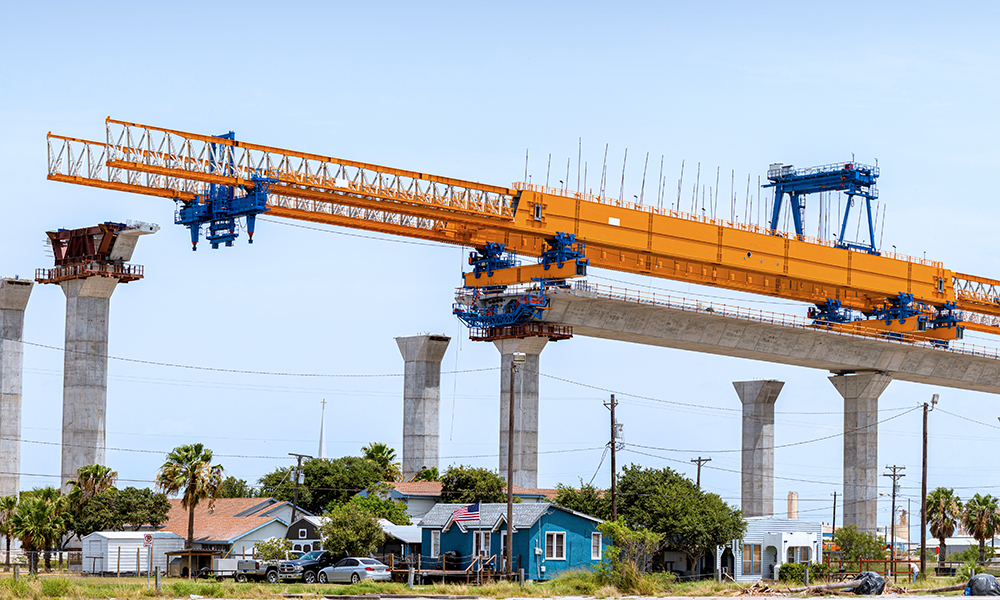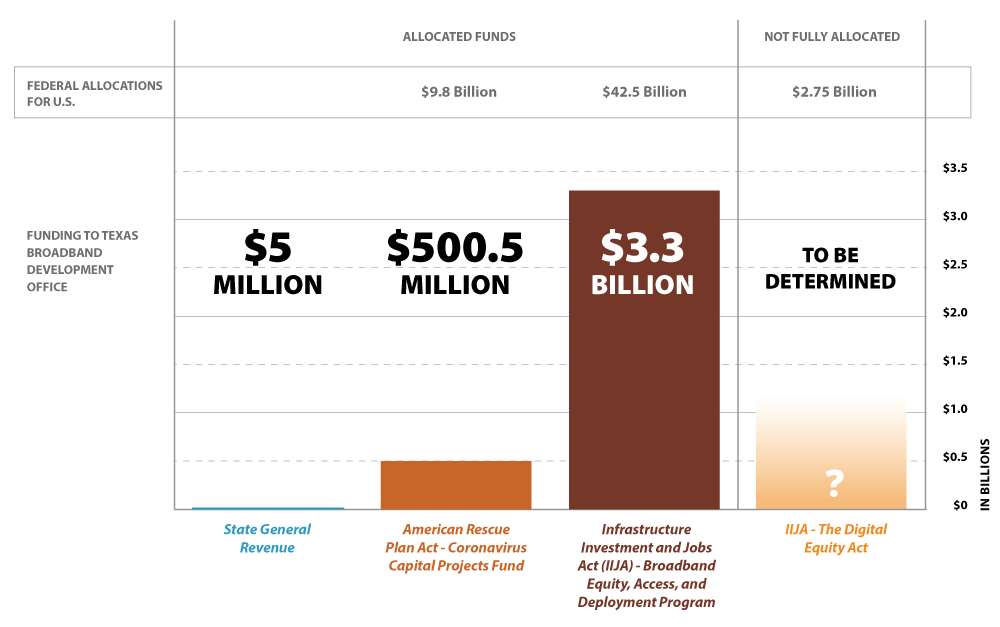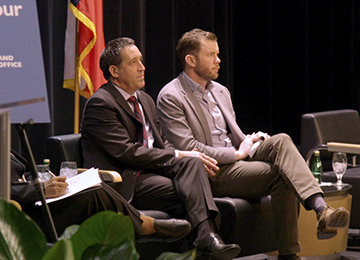Building Strong Infrastructure for a Growing Texas Lawmakers Ask Voters to Approve Additional Infrastructure Funding

From public roads to transmission lines, from water pipelines to broadband access, the elements of Texas’ infrastructure are the bones that support its sturdy economy; its pro-business bona fides rely on strong infrastructure to support 30 million (and growing) Texans where they live, work and play. Given the high stakes, state leaders and lawmakers have embraced the challenge of building and maintaining a strong infrastructure.
Keeping up with the state’s population growth is a tall order: Six of the fastest-growing cities in the nation last year were in Texas, and the U.S. Census Bureau says the state has grown by more than 9 million people since 2000, doubling the population of 11 counties.
The Texas Section of the American Society of Civil Engineers (ASCE), which issues an Infrastructure Report Card (IRC) every four years, points to the state’s fast growth as putting pressure on already stressed infrastructure.
“The latest IRC uncovered an investment gap of tens of billions of dollars needed to address shortfalls for the repair and necessary new construction of highways, bridges, levees, transit, wastewater, drinking water, flood risk and dams,” says Travis Attanasio, ASCE Texas Section president. “Should there be no action, additional untold billions of dollars will be needed … should there be a catastrophic failure of the existing overly strained infrastructure.”
The group’s report card checklist also includes aviation, energy, public parks and recreation, and solid waste, but leaves out other areas such as broadband.
The 88th Legislature’s access to a historic amount of funds along with some helpful federal dollars through 2021’s Infrastructure Investment and Jobs Act (IIJA) set the stage for improvement. This story explores where some money is headed and what is left for Texas voters to decide.
EXHIBIT 1: BROADBAND FUNDING FOR TEXAS

- Texas got 5 million dollars from General Revenue
- The federal government allocated 9.8 billion dollars to Texas from the American Rescue PLan Act - Coronavirus Captial Projects Fund. 500.5 million dollars of that went to BDO.
- The federal government allocated 42.5 billion dollars to Texas from the Infrastructure Investment and Jobs Act (IIJA) - Broadband Equity, Access and Deployment program. 3.3 billion dollars of that went to BDO.
- Another 2.75 billion dollars - not fully allocated - is coming from IIJA the The Digital Equity Act. The portion of that allocation going to BDO is still to be determined.
Note: Another $1.5 billion for broadband and telecommunications projects would be made available
through general revenue if voters approve Proposition 8 in the November election.
Source: Texas Broadband Development Office
Broadband Infrastructure – Connecting Texas
Broadband infrastructure describes the physical equipment and facilities that enable high-speed and high-capacity transmission of data, voice and video over the internet. Bringing fast internet service to Texas’ wide-open spaces is a challenge that state leaders and lawmakers have been working hard to address — notably with the creation of the Broadband Development Office (BDO) under the Texas Comptroller of Public Accounts in 2021.

Comptroller Glenn Hegar spoke to the media during 2022’s statewide Broadband Listening Tour, where Texans shared the impacts of broadband on their lives and businesses.
This year, the 88th Legislature built on its work with a proposed constitutional amendment that — if approved by voters in November — will create the Broadband Infrastructure Fund to direct $1.5 billion to broadband and telecommunications projects.
Funding is important because the high cost of deploying broadband infrastructure throughout the state has been the highest hurdle for access (Exhibit 1). This challenge has been addressed in prominent federal measures, including those passed after the nation was struck by the COVID-19 pandemic.
The pandemic highlighted the critical need for reliable, affordable access to broadband for remote work, education, health care and civic engagement. Many Texans, especially in rural areas, lack access to broadband service that meets the minimum speed requirements of 25 megabits per second (Mbps) download and 3 Mbps upload. According to experts, it takes 0-5 Mbps to check email, stream music on one device and search the internet. Downloading large files and streaming video on one device requires 5-40 Mbps. The U.S. Census Bureau reports 93.9 percent of Texas households had a computer, but only 86.9 percent had a broadband internet subscription in 2017-2021.
In June, Texas was allocated $3.3 billion as part of the Broadband Equity, Access, and Deployment (BEAD) Program, a $42.5 billion component of the IIJA passed by Congress in 2021 for the purpose of ensuring every American has access to reliable internet. Texas received the largest allocation of any state. The BDO anticipates it will begin accepting grant applications for the BEAD Program in 2024. Eligible applicants include internet service providers, political subdivisions and public-private partnerships interested in developing broadband infrastructure.
Experts estimate as many as 3.9 million households in Texas are eligible for the Affordable Connectivity Program, which cuts internet bills by up to $75 a month for subscribers who qualify. About 1.6 million households in Texas were enrolled in the program as of August 2023.

Comptroller Hegar and Broadband Development Office Director Greg Conte conducted 12 town hall forums, gathering testimony about broadband access from nearly 1,000 attendees.
“I am very pleased to see this historic investment in Texas,” says Comptroller Glenn Hegar, who has pushed to address infrastructure needs including broadband access. “Critical infrastructure projects across the state will get much-needed attention that will help us increase access to reliable, high-speed internet and close the availability gap in Texas.”
People can sign up to receive updates from the BDO and learn about ways to provide feedback regarding their connectivity needs.
The Roads Ahead
The 88th Legislature made a significant investment in the state’s transportation system, says Trent Thomas, director of government affairs at the Texas Department of Transportation (TxDOT).
“All of the people moving to Texas are bringing their cars with them, and you see that on our roads,” Thomas says. “But the Legislature also invested in other important infrastructure — airports and maritime ports.”
The $37.2 billion TxDOT budget reflects significant investments in multimodal transportation and freight systems, increasing funding for rural and small urban transit, maritime ports, rail and general aviation, he says (Exhibit 2).
Exhibit 2: HOUSE BILL 1 — TXDOT FUNDING USES, FISCAL YEARS 2024-2025
| Budget Uses | Amount | Percentages |
|---|---|---|
| Maintenance and Preservation | $13.9 billion | 37.3 |
| Project Delivery | $12.1 billion | 32.5 |
| Project Development | $6.74 billion | 18.1 |
| Borrowed Funds Repayment | $2.2 billion | 5.9 |
| Administration and Support | $0.88 billion | 2.4 |
| Other Modes and Services | $0.81 billion | 2.2 |
| Regional Project Subaccounts | $0.47 billion | 1.2 |
| Salary Adjustments | $0.14 billion | 0.4 |
| Total | $37.23 billion |
Note: Totals and percentages may not sum due to rounding.
Source: Texas Department of Transportation
Thomas says the extension of key highway and transportation funding sources, Proposition 1 and Proposition 7, mark “major accomplishments” of the session and reflect more than 35 percent of TxDOT’s total budget.
“Renewing these funding mechanisms ensures stability,” he says. “This allows for consistent planning over the entirety of current and future 10-year planning periods.”
Respectively, House Bill 2230 and Senate Concurrent Resolution 2 extend funding sources initiated in 2014 and 2015: First approved by voters in 2014, Proposition 1 dedicates a portion of existing oil and natural gas production taxes to the State Highway Fund until 2042, the extended date. The money may only be used for constructing, maintaining and acquiring rights-of-way for public roadways other than toll roads. The Comptroller’s office estimates Proposition 1 deposits will total $3.06 billion in fiscal 2024.
Proposition 7 was extended for 10 more years, dictating that when state motor vehicle sales and rental taxes exceed $5 billion, 35 percent of that overage will be directed to roads. Based on the Comptroller’s Biennial Revenue Estimate from January 2023, TxDOT expects to receive $692.14 million and $740.63 million in state motor vehicle sales and rental tax revenues in fiscal 2024 and 2025, respectively. The state also must share $2.5 billion of state sales and use tax with the highway fund once collections surpass $28 billion.
One happy surprise from the session is a historic investment in Texas seaports by the Legislature, Thomas said.
“Each port is different and all of them are critical for business, whether they’re working with the energy sector or importing and exporting goods,” Thomas says. “Texas is making a $400 million investment in the Ship Channel Improvement Revolving Fund (SCIRF) that allows for low-interest, flexible loans for federally authorized projects for widening and deepening existing ship channels.”
Senate Bill 1499 reauthorizes and clarifies uses of the Port Access (Capital) Account Fund, which provides $200 million in grants for infrastructure improvement; no more than 20 percent of that can go to one project, ensuring the funds are spread around.
The Texas Legislature provided an additional $94 million for general aviation airports for capital and maintenance.
Water Infrastructure – Filling in the Gaps
To address the crucial need for water for Texas’ growing population, lawmakers proposed creating the Texas Water Fund to be administered by the Texas Water Development Board. The Board would be authorized to transfer funds between the state Water Fund and the Water Assistance Fund No. 480, the New Water Supply for Texas Fund, the Rural Water Assistance Fund No. 301 or the Statewide Water Public Awareness Account. The state budget allocates $1 billion to the Texas Water Fund, subject to voter approval in November.
Powering Texas
The 88th Legislature once again sought to improve the reliability of Texas’ independent power grid through several measures that seek to encourage new generation and increase reserves during emergencies.
If Texas voters approve a constitutional amendment in November, a new Texas Energy Fund would encourage dispatchable generation projects through low-interest loans and grants.
The budget allocates $5 billion toward the fund, which would be administered through the Public Utility Commission of Texas (PUC) and invested by the Texas Treasury Safekeeping Trust Company.
The fund would provide 3 percent, 20-year loans to cover 60 percent of total project costs for upgrades to existing generation facilities and help finance new construction for at least 100-megawatt capacity. It also would provide bonus grants to new dispatchable generation built before certain deadlines.
The measure also aims to reduce the grid’s vulnerability by allowing the PUC to award up to $1.8 billion in loans and grants called Texas Backup Power Packages to encourage power reserves that would provide 48 hours of generation to critical facilities like schools, hospitals, nursing homes and community centers.
Another law passed this session will shift some transmission infrastructure costs for wind and solar back to the generation companies, along with other measures aimed at cost control.
Building a Solid Foundation
Voters will decide three infrastructure-related amendments this November
See the full list of constitutional amendments on the Nov. 7 ballot at VoteTexas.gov.
- Water: Proposition 6 – The constitutional amendment creating the Texas Water Fund to assist in financing water projects in this state.
- Energy: Proposition 7 – The constitutional amendment providing for the creation of the Texas Energy Fund to support the construction, maintenance, modernization and operation of electric generating facilities.
- Broadband: Proposition 8 – The constitutional amendment creating the Broadband Infrastructure Fund to expand high-speed broadband access and assist in the financing of connectivity projects.
The condition of Texas’ infrastructure will remain under the microscope as investment strengthens the framework that supports Texas’ robust economic activity.
“Broadband infrastructure is the interstate highway system of this century, while a strong transportation network and reliable water resources are crucial to our citizens’ well-being,” says Hegar. “We welcome our state’s economic growth, and that means we must ensure we invest in the essentials for businesses and individuals to continue to flourish.” FN
Learn more about the state’s energy infrastructure with the Good for Texas Tour: Energy Edition. And read about last year’s Good for Texas Tour highlighting water use and innovation.

